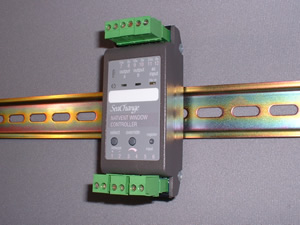| Feature Notes |
Configuration Tables | Data Sheet Not yet Released |
Wiring | History |
Feature Notes |
Datasheet |
Actuator Submodule for Natural Ventilation Window Control |
|
Latest released version is 4c2 (beta)Document last updated 24/01/2002 |
ACT / DIN / NAT / 3T / ...ACT / DIN / NAT / AOP / ... |
Main FeaturesControls Automatic Windows or Dampers in Naturally Ventilated buildingsWorks with SeaChange AHU, Zone or Secondary Circuit Controller |
 |
Compass Point |
Bearing |
North |
0 |
North East |
45 |
East |
90 |
South East |
135 |
South |
180 |
South West |
225 |
West |
270 |
North West |
315 |
North |
360 |

Heating |
Cooling |
Output A |
Output B |
Output C |
/ 101 |
/ 201 |
Time Proportional |
Not used |
Occupation or Optimum start switch |
/ 105 |
/ 205 |
Window/Damper Open |
Window/Damper Close |
Occupation or Optimum start switch |
/ 108 |
/ 208 |
Sequence 2 triacs at 33% and |
66% of demand |
Occupation or Optimum start switch |
/ 109 |
/ 209 |
Sequence 3 triacs at 25%, |
50% and |
75% of demand |
Heating |
Cooling |
Output A |
Output B |
/ 701 |
/ 801 |
Time Proportional * |
Occupation or Optimum Start Switch * |
/ 705 |
/ 805 |
Raise / Lower * |
Occupation or Optimum Start Switch * |
/ 721 |
/ 821 |
0-100% Demand = 0-10V dc |
Occupation or Optimum Start Switch * |
/ 722 |
/ 822 |
0-50% Demand = 0-10V dc |
50-100% Demand = 0-10Vdc |
/ 731 |
/ 831 |
Sequenced - 2 stages * |
Occupation or Optimum Start Switch * |
/ 732 |
/ 832 |
Sequenced - 3 stages * |
Occupation or Optimum Start Switch * |
/ 733 |
/ 833 |
Sequenced - 8 stages * |
Occupation or Optimum Start Switch * |
Input Configuration (3T and AOP) |
|
Input 3-4 ‘input a’ |
Temperature sensor (optional) or VFC status / alarm / occupancy |
Input 5-6 ‘input b’ |
Temperature sensor (optional) |